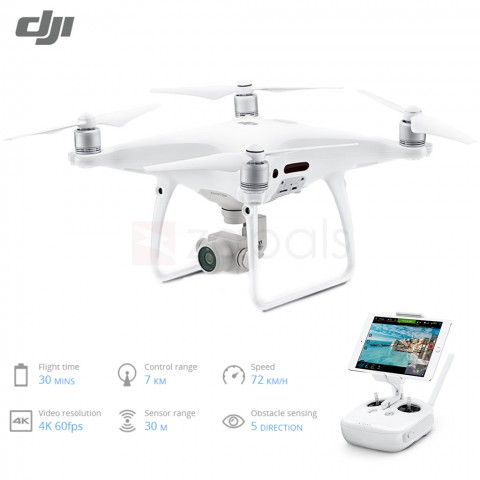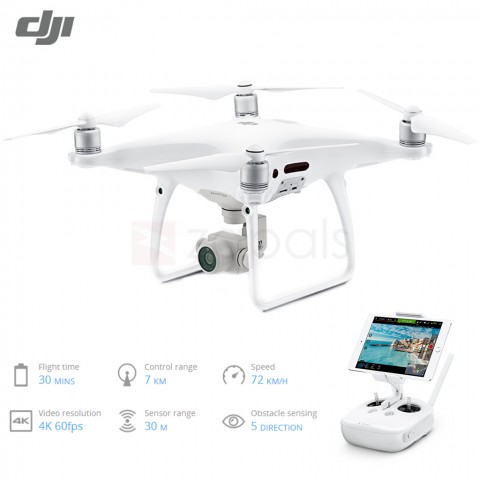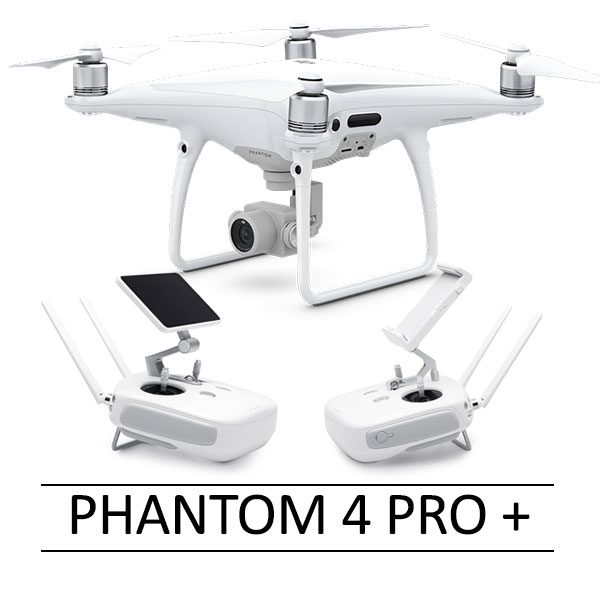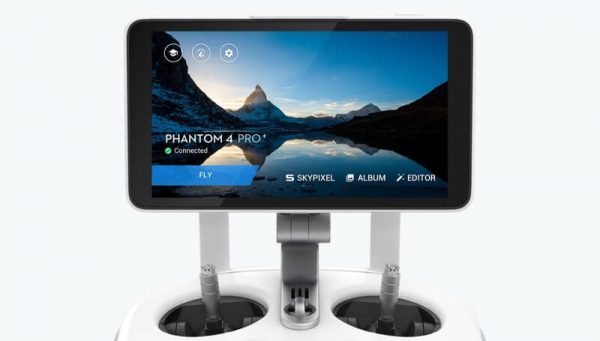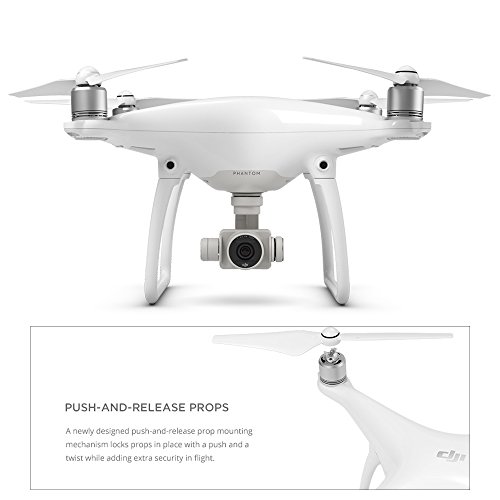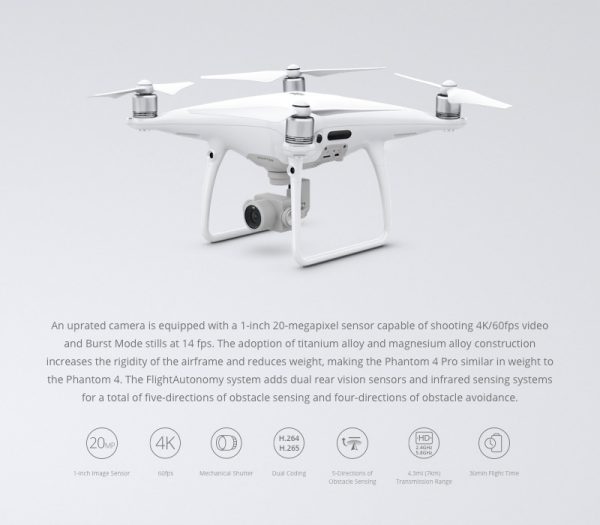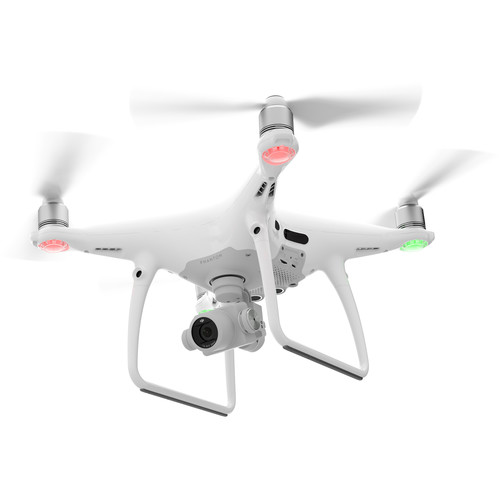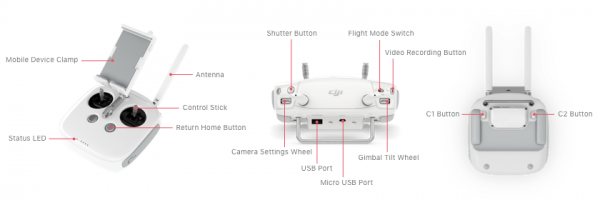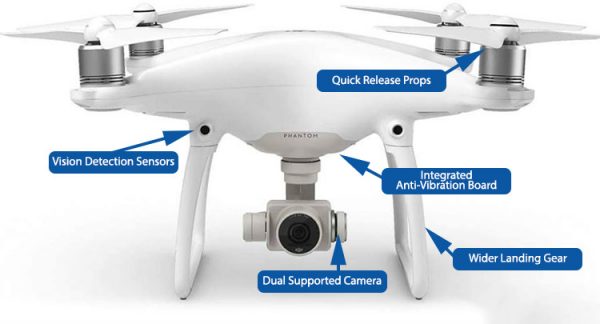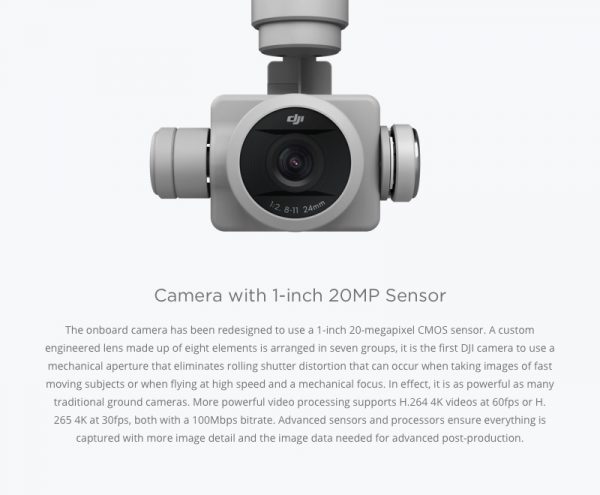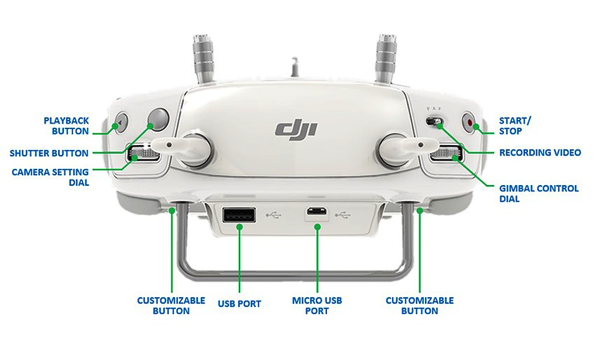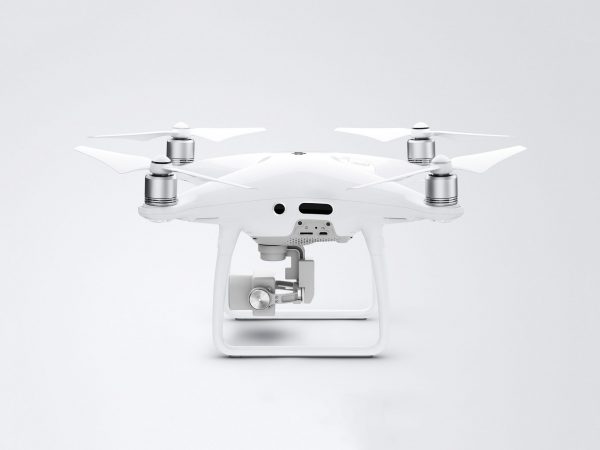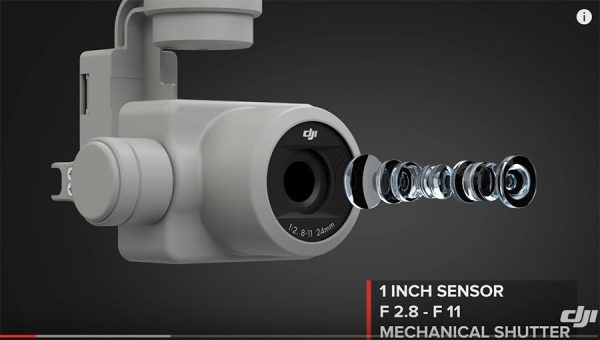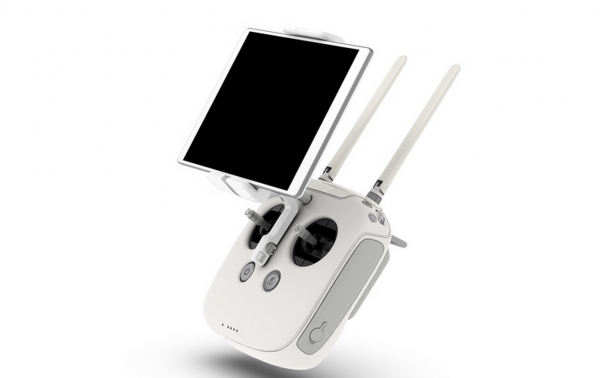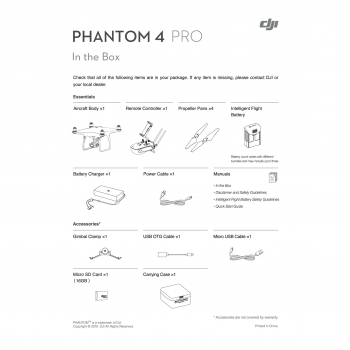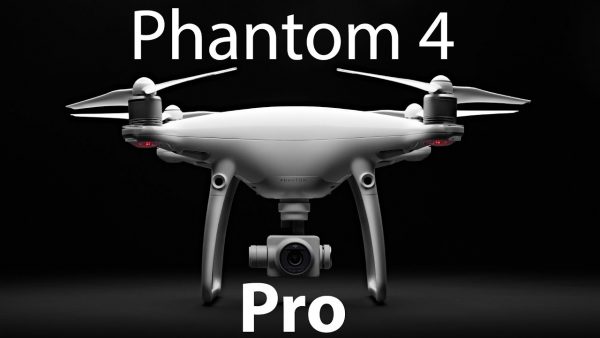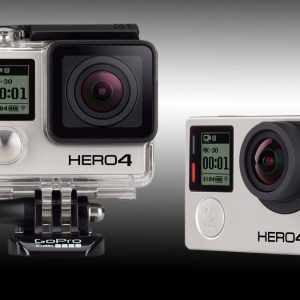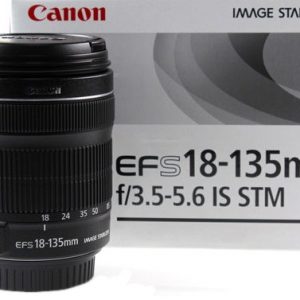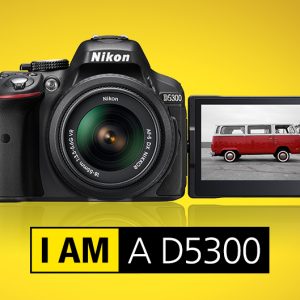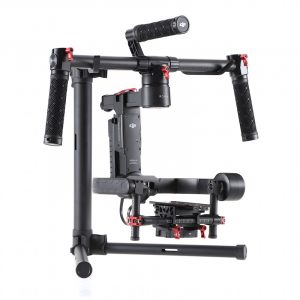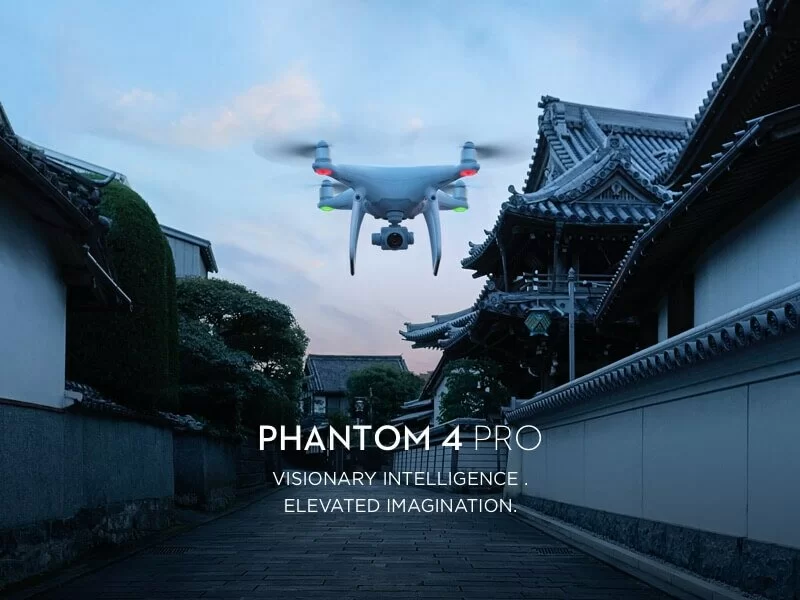 |
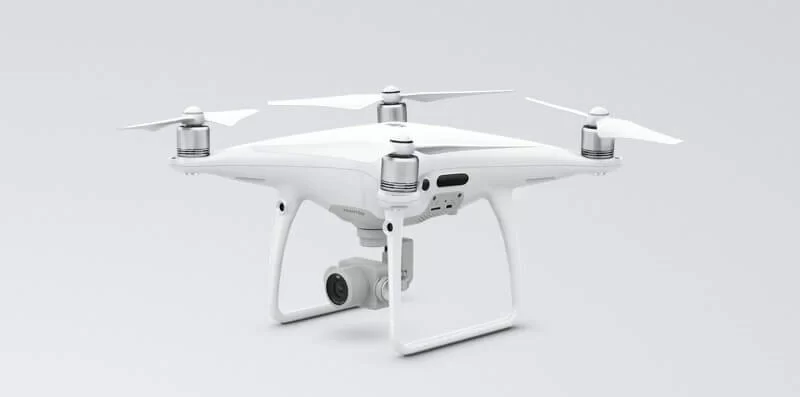
|
An uprated camera is equipped with a 1-inch 20-megapixel sensor capable of shooting 4K/60fps video and Burst Mode stills at 14 fps. The adoption of titanium alloy and magnesium alloy construction increases the rigidity of the airframe and reduces weight, making the Phantom 4 Pro similar in weight to the Phantom 4. The FlightAutonomy system adds dual rear vision sensors and infrared sensing systems for a total of 5-direction of obstacle sensing and 4-direction of obstacle avoidance.
|

|
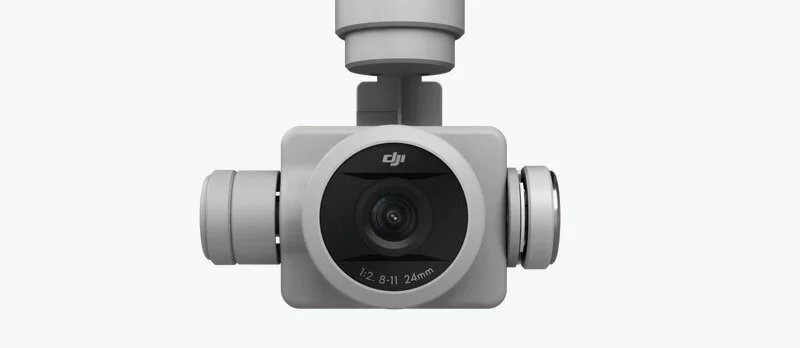
CAMERA WITH 1-INCH 20MP SENSOR
The onboard camera has been redesigned to use a 1-inch 20-megapixel CMOS sensor. A custom engineered lens made up of eight elements is arranged in seven groups, it is the first DJI camera to use a mechanical shutter, eliminating rolling shutter distortion which can occur when taking images of fast moving subjects or when flying at high speed. In effect, it is as powerful as many traditional ground cameras. More powerful video processing supports H.264 4K videos at 60fps or H.265 4K at 30fps, both with a 100Mbps bitrate. Advanced sensors and processors ensure everything is captured with more image detail and the image data needed for advanced post-production.
|
|
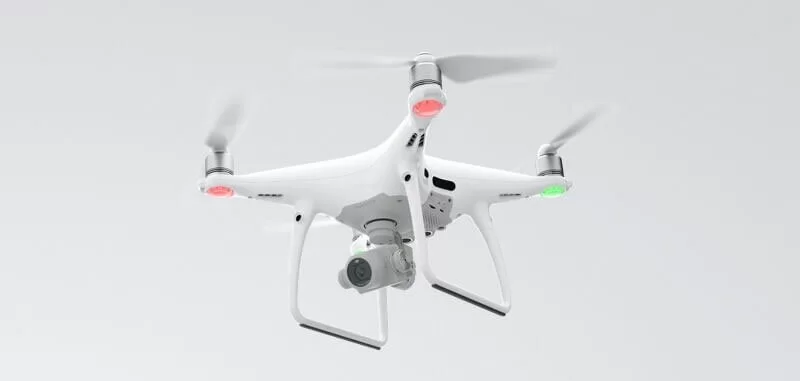
FIVE-DIRECTIONS OF OBSTACLE SENSING
FlightAutonomy is expanded with an additional set of high-resolution stereo vision sensors placed at the rear in addition to the pair placed at the front as well as infrared sensing systems placed on the left and right sides. This network creates a total of five-directions of obstacle sensing and four-directions of obstacle avoidance, protecting the Phantom 4 Pro from more obstacles and giving filmmakers the confidence to capture more complex images.
|
|
REMOTE CONTROLLER WITH BUILT-IN SCREEN
The Phantom 4 Pro controller integrates an upgraded Lightbridge HD video transmission system that adds 5.8 GHz transmission support. The ability to choose between 2.4Ghz and 5.8Ghz allows pilots to cut through interference and eliminates image lag caused when flying in an area with extensive 2.4Ghz frequency use. Normally, Wi-Fi video transmission systems use a 2.4GHz frequency to work with a controller using a 5.8GHz frequency as this prevents interference that can occur when both use the same frequency. To perform normally, the video transmission system and the controller will interfere with each other causing image lag, especially if both use the same frequency. The use of two different frequencies has drawbacks in terms of flight performance. For example, flight performance will be affected when either of the two frequencies suffer interference.
The Lightbridge HD video transmission system used in the Phantom 4 Pro uses TDM (Time Division Multiplexing) to transmit signals, allowing it to send controller signals and receive video transmission signals at the same frequency. As the 2.4GHz frequency band is often affected by Wi-Fi, 4G cell towers, and other types of interference in urban areas, a 5.8Ghz band will increase transmission reliability. When switched on, the Phantom 4 Pro evaluates local signal levels, automatically choosing the transmission frequency with the lowest level of interference. This ensures the optimum range of a maximum video transmission of 4.3mi (7km)*
A 5.5in 1080p screen integrated with the Phantom 4 Pro+ offers 1000 cd/m2 of brightness, more than twice as bright as conventional smart devices. It makes bright, vivid colors easily visible in direct sunlight. With this screen, a mobile device is not required, simplifying pre-flight preparations. As the DJI GO app is built into the screen, hardware and software can be fully optimized, further reducing video lag. Integration of an HDMI port, Micro-SD card slot, microphone, embedded loudspeaker, and Wi-Fi connection allow images to be edited inside DJI GO to be shared almost instantly. Lastly, a five-hour battery life makes the Phantom 4 Pro + a complete aerial imaging solution.
*Unobstructed, free of interference, when FCC compliant.
|

|
 |
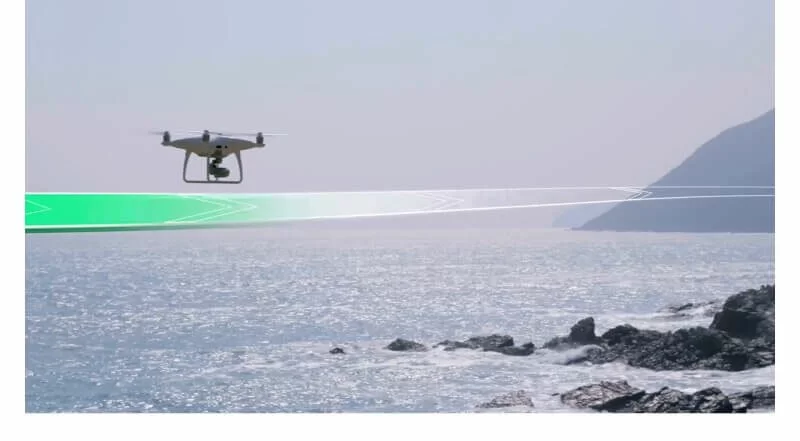
Draw
Draw is a brand new technology for waypoint control. Simply draw a route on screen and the Phantom 4 Pro will move in that direction while keeping its altitude locked. This allows the pilot to focus on camera control and enables more complex shots. There are two Draw modes that can be used in different scenarios.
Standard: The aircraft follows the route at a constant speed with the camera facing in the direction of flight. Free: The aircraft only moves along the route when instructed. In this mode, the camera can face in any direction during a flight.
|
|
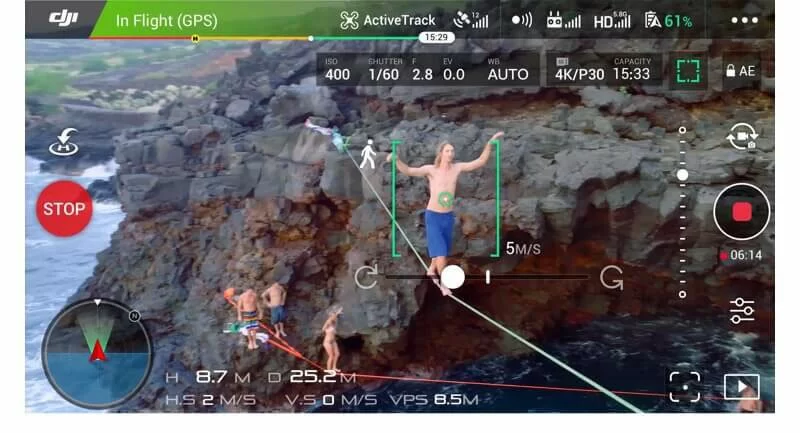
ActiveTrack
The Phantom 4 Pro automatically recognizes subjects, follows and captures them as they move, making it easier to get complex shots.
Following fast-moving objects can be very challenging, but advanced image recognition algorithms used by the Phantom 4 Pro allow it to recognize and track the object while keeping it in frame. This new algorithm also recognizes more subjects, from people to vehicles to animals, and will adjust its flight dynamics to match, ensuring smoother shots.
Pilots can now choose between:
Trace – Follow behind or in front of a subject, avoiding obstacles automatically.
Profile – Fly alongside a subject at a variety of angles to get profile shots of the subject. Spotlight – Keep the camera trained on a subject while the aircraft flies almost anywhere.
|
|
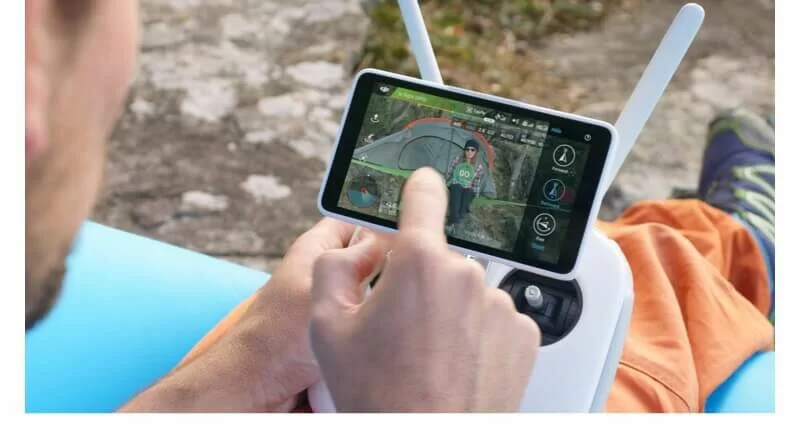
TapFly
Fly in any direction visible on-screen with a simple tap. Tap anywhere on-screen to smoothly adjust the direction of flight while automatically avoiding obstacles * and tap the screen again or use control sticks to change direction. A new AR route function shows the aircraft’s real-time flight direction for reference as its route is adjusted. As it can be difficult to control altitude, course, speed and camera pitch simultaneously using joysticks, TapFly Free allows a pilot to set the direction of flight, allowing them to turn the Phantom 4 Pro or tilt the gimbal as required without changing the direction of flight. In total, there are now three TapFly modes:
TapFly Forward – Tap to fly in the selected direction
TapFly Backward – Tap to fly in the opposite direction of the tap, i.e. tap in the bottom right corner of the screen to fly backward towards the top left.
TapFly Free – Lock the forward direction of the Phantom without locking the camera direction allowing it to turn as it flies.
*Obstacle Avoidance is not available with TapFly Free
|
|
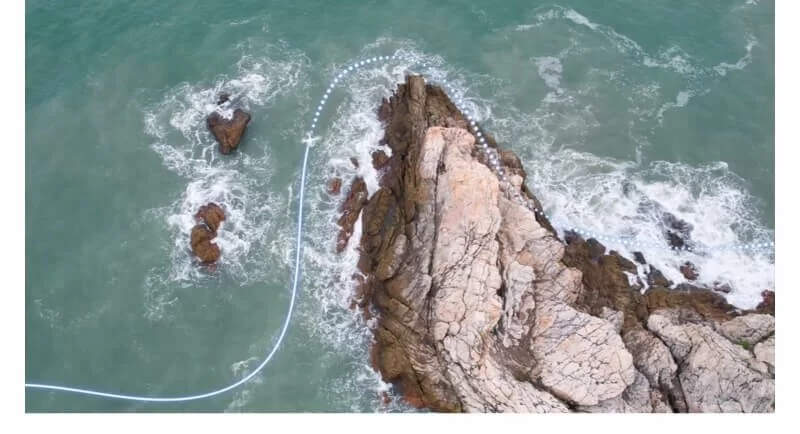
Return to Home
In its upgraded Return to Home mode, the Phantom 4 Pro can automatically choose the best route to return home depending on environmental conditions. It records its route as it flies, allowing it to return along the same route avoiding obstacles if the control signal is disconnected.
Based on its altitude at the time of disconnection, the Phantom 4 Pro is also able to adjust its flight path to avoid obstacles it has seen during its flight. At takeoff, the Phantom 4 Pro will record the scene below and compare its recording with what it sees as it returns, for more precise landing. It can also detect the ground to see whether there is suitable spot for landing. If any obstacles are found, or there is water on the ground, it will alert the pilot and hover at an appropriate height, helping the aircraft to land more safely.
|
|

Gesture Mode
Using Gesture Mode, selfies can be captured easily using a few gestures without the remote controller. Advanced computer vision technology allows the Phantom 4 Pro to take instructions through gestures. The subject simply lifts their arms when facing the camera and the aircraft will recognize this movement by locking on and placing the subject in the center of the frame. When ready for a photo, the subject holds their arms out to signal the aircraft. A three second countdown will begin, making time to strike a pose, allowing moments to be captured without the remote control.
|
|
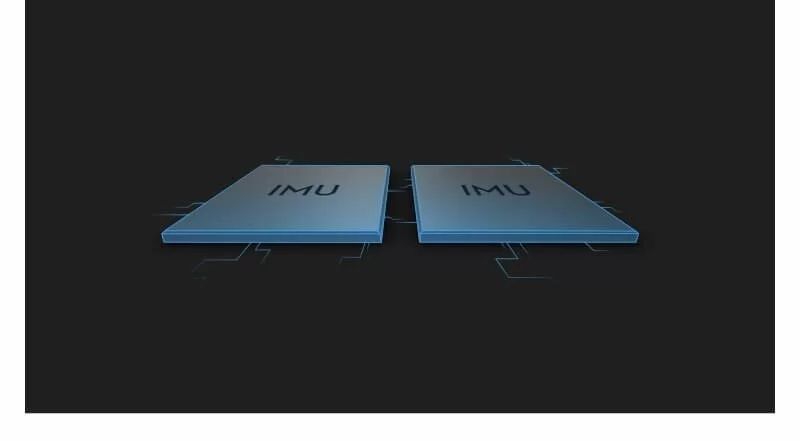
Sensor Redundancy
The Phantom 4 Pro features dual compass modules and dual IMU units, making it more reliable when compared to many hexacopters and octocopers. Compasses and IMUs are important sensors to ensure a stable flight and the Phantom 4 Pro constantly compares the data it receives through both pairs. This data is run through advanced algorithms to check accuracy and any inaccurate data is simply discarded without affecting flight, keeping flight steady and reliable.
|
|
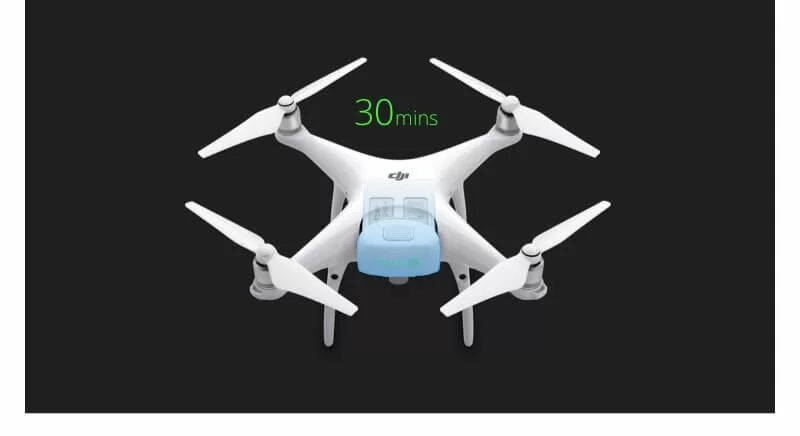
Intelligent Batteries
Professional aerial imaging benefits from longer flight times. The Phantom 4 Pro has a maximum flight time of 30 minutes, providing more time in the air to capture the perfect shot. The DJI GO app shows battery lifetime and calculates remaining flight times according to distance traveled and more. It will give alerts when it reaches a minimum safe amount required for a safe journey back to the takeoff point. An advanced battery management system is also in place to prevent overcharging and over draining. When placed in longer term storage, batteries will discharge power to maintain good health.
|
|
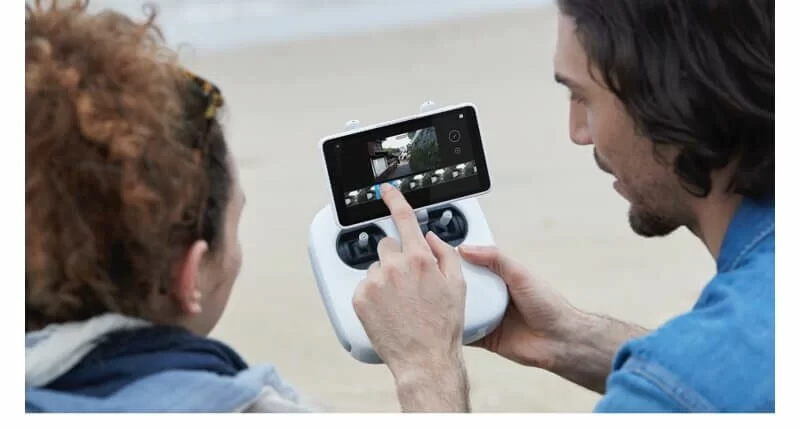
DJI GO
When shooting aerials, the remote controller is responsible for most physical controls including piloting and capture. However, more challenging shoots require a real-time video feed, vital flight statistics and advanced settings. These are traditionally handled through a smart device, making the smart device essential to aerial imaging. The DJI GO app is optimized for aerials and is updated along with the aircraft to ensure all features are supported. It can be used on smart devices and is available to be integrated into the DJI Crystalsky monitor, providing simple and convenient control.
Using the DJI GO app, a large number of Intelligent Fight Modes are available. It also provides access to full manual camera controls, including ISO, aperture, shutter speed, image formats, and more. Any changes in DJI GO will appear almost instantly on-screen. Vital flight data and video transmission status are easy to check in-app, further enhancing control efficiency and convenience.
DJI GO includes editing features for quick editing and sharing to social media and even live streaming. After each flight, flight routes and data are automatically recorded and synchronized to the attached DJI GO account, keeping it readily accessible for you to review. Both flight logs and data are easy to record and review.
AIRCRAFT
| Weight (Battery & Propellers Included) |
1388 g |
| Diagonal Size (Propellers Excluded) |
350 mm |
| Max Ascent Speed |
S-mode: 6 m/s; P-mode: 5 m/s |
| Max Descent Speed |
S-mode: 4 m/s; P-mode: 3 m/s |
| Max Speed |
45 mph (72 kph) (S-mode); 36 mph (58 kph) (A-mode); 31 mph (50 kph) (P-mode) |
| Max Tilt Angle |
42° (S-mode); 35° (A-mode); 25° (P-mode) |
| Max Angular Speed |
250°/s (S-mode); 150°/s (A-mode) |
| Max Service Ceiling Above Sea Level |
19685 ft (6000 m) |
| Max Flight Time |
Approx. 30 minutes |
| Operating Temperature |
32° to 104° F ( 0° to 40° C) |
| Satellite Positioning Systems |
GPS/GLONASS |
| GPS Hover Accuracy Range |
Vertical: ±0.1 m (With Vision Positioning); ±0.5 m (With GPS Positioning)
Horizontal: ±0.3 m (With Vision Positioning); ±1.5 m (With GPS Positioning) |
VISION SYSTEM
| Velocity Range |
≤31 mph (50 kph) at 6.6 ft (2 m) above ground |
| Altitude Range |
0 – 33 ft (0 – 10 m) |
| Operating Range |
0 – 33 ft (0 – 10 m) |
| Obstacle Sensory Range |
2 – 98 ft (0.7 – 30 m) |
| FOV |
±60°(Horizontal), ±54°(Vertical) |
| Detection Frequency |
10Hz |
| Operating Environment |
Surfaces with clear patterns and adequate lighting (> 15 lux) |
CAMERA
| Sensor |
1’’ CMOS; Effective pixels: 20M |
| Lens |
FOV (Field of View) 84°, 8.8 mm / 24 mm (35 mm format equivalent),
f/2.8 – f/11.
auto focus at 1 m – ∞ |
| ISO Range |
Video: 100 – 3200 (Auto); 100 – 6400 (Manual)
Photo: 100 – 3200 (Auto); 100- 12800 (Manual) |
| Mechanical Shutter |
8 – 1/2000 s |
| Electronic Shutter |
8 – 1/8000 s |
| Max Image Size |
3:2 Aspect Ratio: 5472 × 3648
4:3 Aspect Ratio: 4864 × 3648
16:9 Aspect Ratio: 5472 × 3078 |
| PIV Image Size |
16:9 Aspect Ratio:
・5248 × 2952(3840 × 2160 24/25/30p,2720 × 1530 |
24/25/30p,
1920 × 1080 24/25/30p, 1280 × 720 24/25/30p)
・3840 × 2160(3840 × 2160 48/50p,2720 × 1530 48/50p,
1920 × 1080 48/50/60p,1280 × 720 48/50/60p)
17:9 Aspect Ratio:
・4896 × 2592 (4096 × 2160 24/25/30p)
・4096 × 2160 (4096 × 2160 48/50p) |
| Still Photography Modes |
Single Shot
Burst Shooting: 3/5/7/10/14 frames
Auto Exposure Bracketing (AEB): 3/5 bracketed
frames at 0.7EV Bias
Interval: 2/3/5/7/10/15/30/60 s |
| Video Recording Modes |
H.265
・C4K:4096×2160 24/25/30p @100Mbps
・4K:3840×2160 24/25/30p @100Mbps
・2.7K:2720×1530 24/25/30p @65Mbps2720×1530 48/50/60p @80Mbps
・FHD:1920×1080 24/25/30p @50Mbps1920×1080 48/50/60p @65Mbps
1280×720 48/50/60p @35Mbps
H.264
・C4K:4096×2160 24/25/30/48/50/60p @100Mbps
・4K:3840×2160 24/25/30/48/50/60p @100Mbps
・2.7K:2720×1530 24/25/30p @80Mbps
2720×1530 48/50/60p @100Mbps
・FHD:1920×1080 24/25/30p @60Mbps
1920×1080 48/50/60/120p @80Mbps
・HD: 1280×720 24/25/30p @30Mbps
1280×720 48/50/60/120p @45Mbps |
| Video Storage Bitrate |
100 Mbps |
| Supported File Systems |
FAT32 (≤ 32 GB); exFAT (> 32 GB) |
| Photo |
JPEG, DNG (RAW), JPEG + RAW |
| Video |
MP4/MOV (AVC/H.264;HEVC/H.265) |
| Supported SD Cards |
Micro SD, Max Capacity: 128GB.
Write speed ≥15MB/s, class 10 or UHS-1 rating required |
| Operating Temperature |
32° to 104° F (0° to 40° C) |
CHARGER
| Voltage |
17.4 V |
| Rated Power |
100 W |
GIMBAL
| Stabilization |
3-axis (pitch, roll, yaw) |
| Controllable Range |
Pitch: -90° to +30° |
| Max Controllable Angular Speed |
Pitch: 90°/s |
| Angular Control Accuracy |
±0.03° |
TOF SENSING SYSTEM
| Obstacle Sensory Range |
0.6 – 23 ft (0.2 – 7 m) |
| FOV |
±35° (Horizontal), ±10° (Vertical) |
| Detection Frequency |
10 Hz |
| Operating Environment |
Surface with diffuse reflection material,
and reflectivity > 8% (such as wall, trees, humans, etc.) |
REMOTE CONTROLLER
| Operating Frequency |
2.400 – 2.483 GHz and 5.725 – 5.850 GHz |
| Max Transmission Distance |
FCC Compliant: 4.3mi (7km);
CE Compliant: 2.2mi (3.5km) (Unobstructed, free of interference) |
| Operating Temperature |
32° to 104° F (0° to 40° C) |
| Battery |
6000mAh LiPo 2S |
| Transmitter Power (EIRP) |
2.400 GHz – 2.483 GHz
FCC: 23 dBm; CE: 17 dBm
5.725 GHz – 5.850 GHz
FCC: 30 dBm; CE: 14 dBm |
| Operating Voltage |
1.2 A @7.4 V |
| Video Output Port |
GL300E: USB
GL300F: HDMI,USB |
| Mobile Device Holder |
GL300E: Tablets and smart phones
GL300F: Built-in display device (5.5 inch screen, 1920×1080,
1000 cd/m2, Android system, 4G RAM+16G ROM) |
INTELLIGENT FLIGHT BATTERY (PH4-5870MAH-15.2V)
| Capacity |
5870 mAh |
| Voltage |
15.2 V |
| Battery Type |
LiPo 4S |
| Energy |
89.2 Wh |
| Net Weight |
468 g |
| Charging Temperature Range |
14° to 104° F (-10° to 40° C) |
| Max Charging Power |
100 W |
In the box (Includes 5.5″ Display) :

 Suitable for : Suitable for :

|















